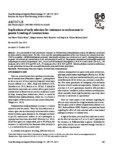Please use this identifier to cite or link to this item:
http://www.alice.cnptia.embrapa.br/alice/handle/doc/1037345| Title: | Implications of early selection for resistance to anthracnose in genetic breeding of common bean. |
| Authors: | PÁDUA, J. M. V.  RAMALHO, M. A. P.   ABREU, A. de F. B.   |
| Affiliation: | JOSÉ MARIA VILLELA PÁDUA, UFLA; MAGNO ANTONIO PATTO RAMALHO, UFLA; ANGELA DE FATIMA BARBOSA ABREU, CNPAF. |
| Date Issued: | 2015 |
| Citation: | Crop Breeding and Applied Biotechnology, v. 15, n. 3, p. 169-174, 2015. |
| Description: | It is questionable if early selection for resistance to Colletotrichum lindemuthianum reduces the efficiency of selection for grain yield in common beans. For this, it was used the segregating population of the cross between two common bean lines: CI107 (susceptible) x BRSMG Madrepérola (resistant). Selection for resistance was carried out in F2 and F3, obtaining three types of progenies: not selected (A), selected only in F2 (B), and selected in F2 and F3 (C). The progenies obtained were evaluated for grain yield and pathogen occurrence in experiments. In F3:5, it was used 289 treatments (96 progenies A, 96 B, 95 C and 2 checks (T)); in F3:6, 196 treatments (64 A, 64 B, 64 C and 4 T); in F3:7, 81 treatments (26 A, 26 B, 26 C and 3 T). Selection of plants resistant to anthracnose in early generations increases the successful selection for grain yield in later generations. |
| Thesagro: | Feijão Phaseolus vulgaris Doença de planta Antracnose Colletotrichum lindemuthianum |
| Keywords: | Melhoramento genético |
| DOI: | 10.1590/1984-70332015v15n3a29 |
| Type of Material: | Artigo de periódico |
| Access: | openAccess |
| Appears in Collections: | Artigo em periódico indexado (CNPAF)  |
Files in This Item:
| File | Description | Size | Format | |
|---|---|---|---|---|
| CNPAF2015cbab.pdf | 406.01 kB | Adobe PDF |  View/Open |









